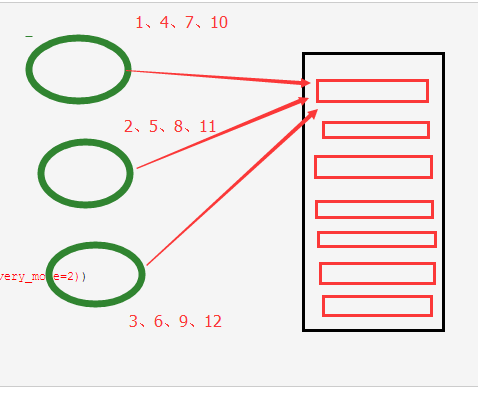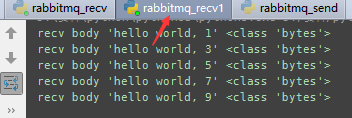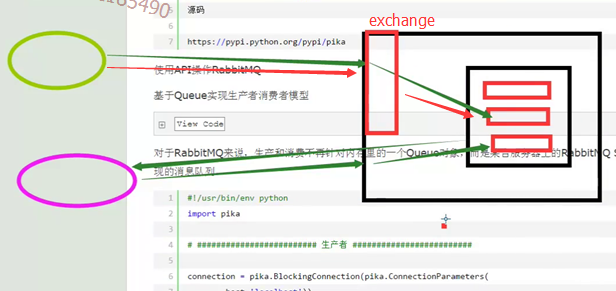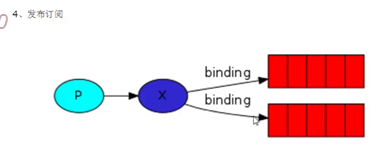python_way day12
1、RabbitMQ
2、pymysql
RabbitMQ
1、基本用法
""" producer """
import pika connection = pika.BlockingConnection(pika.ConnectionParameters(host='192.168.109.134')) #创建链接 channle = connection.channel() #创建频道 channle.queue_declare(queue='chan1') #定义对列,当对列存在就没有意义了.因为producer和consumer谁先连接不一定 channle.basic_publish(exchange='',routing_key='chan1',body="hello world") #1、exchange:定义exchange类型不填写默认是decodle, routing_key 就是往哪个频道发 #向chan1中发送消息 connection.close()
""" consumer """ import pika connection = pika.BlockingConnection(pika.ConnectionParameters(host='192.168.109.134')) channle = connection.channel() #创建频道 channle.queue_declare(queue='chan1') #定义对列 def callback(ch, method, properties, body): print("recv body%r" % body) #内容 print("recv ch%r" % ch) #频道 print("recv method%r" % method) print("recv properties" % properties) #属性 channle.basic_consume(callback, queue='chan1', no_ack=True) #取数据,no_ack 不传确认值,这样可以增加效率,但是可能不是很稳定 channle.start_consuming()
2、保证数据不会丢失
试想一下,如果我们从队列中取完数据,但是我们还没有来得及获取数据,这个时候宕机了,但是数据被取走了,那我们改怎么办?
可以防止这些情况的数据丢失(its channel is closed, connection is closed, or TCP connection is lost)
这是就要在 【收消息一方】 一端用到no_ack了
"""
consumer
"""
import pika
connection = pika.BlockingConnection(pika.ConnectionParameters(host='192.168.109.134'))
channle = connection.channel()
#创建频道
channle.queue_declare(queue='chan1')
#定义对列
def callback(ch, method, properties, body):
print("recv body %r %r" % (str(body,"utf8"), type(body)))
ch.basic_ack(delivery_tag = method.delivery_tag)
#ch就是处理回复确认信息,上面代码处理完我就给队列发送一条消息,如果没有给队列发送消息队列就把取走的信息再放一边
channle.basic_consume(callback, queue='chan1', no_ack=False)
#取数据,no_ack设置成False就是要回复的意思
channle.start_consuming()
#性能上要比上面不回复的差一些,但是安全性提高了
3、这是rabbitmq挂掉了怎么办?
我们可以把数据做持久化
durable
这里就需要在【发数据】一端写上一个字段,告诉rabbitmq
""" producer """ import pika connection = pika.BlockingConnection(pika.ConnectionParameters(host='192.168.109.134')) #创建链接 channle = connection.channel() #创建频道 channle.queue_declare(queue='chan1', durable=True,) #这里写上就报错,是否需要写?? #这里是队列持久化,但是用了就报错 #这里我们使用了durable =True ,意思就是在发数据的时候告诉rabbitmq chan1里的数据要持久化的保存 channle.basic_publish(exchange='',routing_key='chan1',body="hello world",properties=pika.BasicProperties(delivery_mode=2)) #alex 是消息持久化 #properties=pika.BasicProperties(delivery_mode=2) 发数据时就告诉rabbitmq 这条数据给我持久化 #向chan1中发送消息 connection.close()
4、获取消息的顺序
取消息,默认情况下取消息是按照间隔取消息,

但是这样取如果第一个实行的特别慢,二第二个执行的特别快,第二个已经执行到11了,二第一个还在执行1
第1个接收程序

第二个接收程序

如果我们获取队列中按照顺序就要指定 channel.basic_qos(prefetch_count=1) 表示谁来谁取,不再按照奇偶数排列
""" consumer """ import pika connection = pika.BlockingConnection(pika.ConnectionParameters(host='192.168.109.134')) channle = connection.channel() #创建频道 channle.queue_declare(queue='chan1') #定义对列 def callback(ch, method, properties, body): print("recv body %r %r" % (str(body,"utf8"), type(body))) ch.basic_ack(delivery_tag = method.delivery_tag) #ch就是处理回复确认信息 channle.basic_qos(prefetch_count=1)
#谁来谁获取当前排到的队列中的元素 channle.basic_consume(callback, queue='chan1', no_ack=False) #取数据,no_ack设置成False就是要回复的意思 channle.start_consuming()
5、exchange

有了exchange我们只需要向exchange发消息,让exchange判断我们要把消息发给哪一个队列
a. exchange type = fanout ,同时接收消息
这样就是和exchange关联的队列都会接收到消息


import pika connection = pika.BlockingConnection(pika.ConnectionParameters (host='192.168.109.134')) channle = connection.channel() #创建频道 channle.exchange_declare(exchange='logs_fanout',type='fanout') #创建一个队列组,指定队列类型为fanout : 可以将多个队列同时绑定到一个队列组logs_fanout中 result = channle.queue_declare(exclusive=True) queue_name = result.method.queue #随机创建一个队列 #生成一个随机名字 channle.queue_bind(exchange='logs_fanout',queue=queue_name) #将随机队列和队列组绑定 def callback(ch, method, propertise, body): print(" [x] Received %r " % body) channle.basic_consume(callback,queue=queue_name,no_ack=True) #获取这个随机队列名中的消息 channle.start_consuming()

import pika import sys connection = pika.BlockingConnection(pika.ConnectionParameters( host='192.168.109.134')) channel = connection.channel() channel.exchange_declare(exchange='logs_fanout', type='fanout') message = ' '.join(sys.argv[1:]) or "info: Hello World!" channel.basic_publish(exchange='logs_fanout', routing_key='', body=message) print(" [x] Sent %r" % message) connection.close()
#这样就可以多开几个这个 【消费者】,他们可以同时的收到信息了
b.exchange type = direct 关键字发送


import pika import sys connection = pika.BlockingConnection(pika.ConnectionParameters( host='192.168.109.134')) channel = connection.channel() channel.exchange_declare(exchange='direct_logs', type='direct') #指定 exchanges type = direct result = channel.queue_declare(exclusive=True) queue_name = result.method.queue #指定队列名字为随机 severities = sys.argv[1:] if not severities: sys.stderr.write("Usage: %s [info] [warning] [error] " % sys.argv[0]) sys.exit(1) for severity in severities: #循环用户输入的内容 channel.queue_bind(exchange='direct_logs', queue=queue_name, routing_key=severity) #routing_key=severity 绑定exchange和队列名与关键字的关系,我要监听那个队列这个队列 def callback(ch, method, properties, body): print(" [x] %r:%r" % (method.routing_key, body)) channel.basic_consume(callback, queue=queue_name, no_ack=True) channel.start_consuming()

import pika import sys connection = pika.BlockingConnection(pika.ConnectionParameters( host='192.168.109.134')) channel = connection.channel() channel.exchange_declare(exchange='direct_logs', type='direct') severity = sys.argv[1] if len(sys.argv) > 1 else 'info' #关键字等于输入的第二个字段,如果argv小于1 severity就为info message = ' '.join(sys.argv[2:]) or 'Hello World!' #消息为argv的第二个字段或者hello world channel.basic_publish(exchange='direct_logs', routing_key=severity, body=message) #把messages往severity这个关键字中间发送 print(" [x] Sent %r:%r" % (severity, message)) connection.close()
.
c.exchange type = topic 模糊匹配

在topic类型下,可以让队列绑定几个模糊的关键字,之后发送者将数据发送到exchange,exchange将传入”路由值“和 ”关键字“进行匹配,匹配成功,则将数据发送到指定队列。
- # 表示可以匹配 0 个 或 多个 单词
- * 表示只能匹配 一个 单词
发送者路由值 队列中 old.boy.python old.* -- 不匹配 old.boy.python old.# -- 匹配 消费者

import pika import sys connection = pika.BlockingConnection(pika.ConnectionParameters( host='192.168.109.134')) channel = connection.channel() channel.exchange_declare(exchange='topic_logs', type='topic') routing_key = sys.argv[1] if len(sys.argv) > 1 else 'anonymous.info' message = ' '.join(sys.argv[2:]) or 'Hello World!' channel.basic_publish(exchange='topic_logs', routing_key=routing_key, body=message) print(" [x] Sent %r:%r" % (routing_key, message)) connection.close()

import pika import sys connection = pika.BlockingConnection(pika.ConnectionParameters( host='192.168.109.134')) channel = connection.channel() channel.exchange_declare(exchange='topic_logs', type='topic') result = channel.queue_declare(exclusive=True) # queue_name = result.method.queue queue_name = "chan1" #自定的名字,就这证明 topic_logs 这个通道只给chan1这个队列 topic_keys = sys.argv[1:] if not topic_keys: sys.stderr.write("Usage: %s [topic_key]... " % sys.argv[0]) sys.exit(1) for topic_key in topic_keys: channel.queue_bind(exchange='topic_logs', queue=queue_name, routing_key=topic_key) print(' [*] Waiting for logs. To exit press CTRL+C') def callback(ch, method, properties, body): print(" [x] %r:%r" % (method.routing_key, body)) channel.basic_consume(callback, queue=queue_name, no_ack=True) channel.start_consuming()
#实验结果,如果一条信息中的 routing_key 同时被两个队列匹配,消费者是轮询拿结果的。不是同时都能拿到。这个和上面的 direct 不同
作业

二、pymysql
1、使用pymysql执行简单的sql语句
import pymysql conn = pymysql.connect(host='192.168.109.129',port=3306,user='root',passwd='hanxu',db='d1') # 创建游标 cursor = conn.cursor() # 执行SQL,并返回受影响的行数 effect_row = cursor.execute("create table d1.t3(nid int,name char(10))") # 执行SQL,并返回受影响行数
#使用占位符,第二个参数是个元组,就是放替换的元素的, effect_row = cursor.execute("update hosts set host = '1.1.1.2' where nid > %s", (1,)) # 执行SQL,并返回受影响行数 #同时插入多个数据 effect_row = cursor.executemany("insert into hosts(host,color_id)values(%s,%s)", [("1.1.1.11",1),("1.1.1.11",2)]) print(effect_row)
#把上面这些写到内存的数据提交给数据库
conn.commit()
cursor.close() conn.close()
2、获取新创建的自增id
#!/usr/bin/env python # -*- coding:utf-8 -*- import pymysql conn = pymysql.connect(host='127.0.0.1', port=3306, user='root', passwd='123', db='t1') cursor = conn.cursor() cursor.executemany("insert into hosts(host,color_id)values(%s,%s)", [("1.1.1.11",1),("1.1.1.11",2)])
effect_row = cursor.execute("create table d1.t4(nid int not null auto_increment primary key,name char(10))") #新增一个t4表,nid为主键切自增。
conn.commit()
cursor.close()
conn.close()
# 获取最新自增ID
new_id = cursor.lastrowid
#因为上面新增加了2条数据,所以取到的只是最后一条的自增id
3、获取查询数据
#!/usr/bin/env python # -*- coding:utf-8 -*- import pymysql conn = pymysql.connect(host='127.0.0.1', port=3306, user='root', passwd='123', db='t1') cursor = conn.cursor() cursor.execute("select * from hosts") # 获取第一行数据 row_1 = cursor.fetchone() # 获取前n行数据 # row_2 = cursor.fetchmany(3) # 获取所有数据 # row_3 = cursor.fetchall() print(row_1)
print(row_2)
print(row_3)
(1, 'han')
((2, 'xu'), (3, 'tian'), (4, 'huoa'))
None
#注意在一个代码块中每查询一次游标会向下走一行,所以当我们执行完row_1时,在执行row_2这是是从第二行开始向下打印三行的。
conn.commit() cursor.close() conn.close()
注:在fetch数据时按照顺序进行,可以使用cursor.scroll(num,mode)来移动游标位置,如:
- cursor.scroll(1,mode='relative') # 相对当前位置移动 1向下一个位置,-1向上一个
- cursor.scroll(2,mode='absolute') # 相对绝对位置移动
cursor=pymysql.cursors.DictCursor,以字典方式获取查询到的值
上面我们获取的表内容是以元组形式展现的,但是标签我们却不知道
import pymysql conn = pymysql.connect(host='192.168.109.129',port=3306,user='root',passwd='hanxu',db='d1') # 创建游标 cursor = conn.cursor(cursor=pymysql.cursors.DictCursor) #在创建游标的时候指定使用dict #查询 cursor.execute("select * from d1.t4") raw_all = cursor.fetchall() print(raw_all)
[{'name': 'han', 'nid': 1}, {'name': 'xu', 'nid': 2}, {'name': 'tian', 'nid': 3}, {'name': 'huoa', 'nid': 4}, {'name': 'hua', 'nid': 5}, {'name': 'hou', 'nid': 6}]
#这样得到的值就会有标签和参数了。
conn.commit()
cursor.close()
conn.close()
